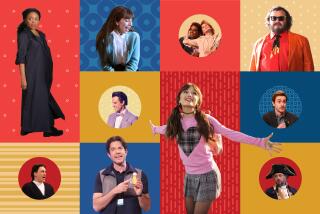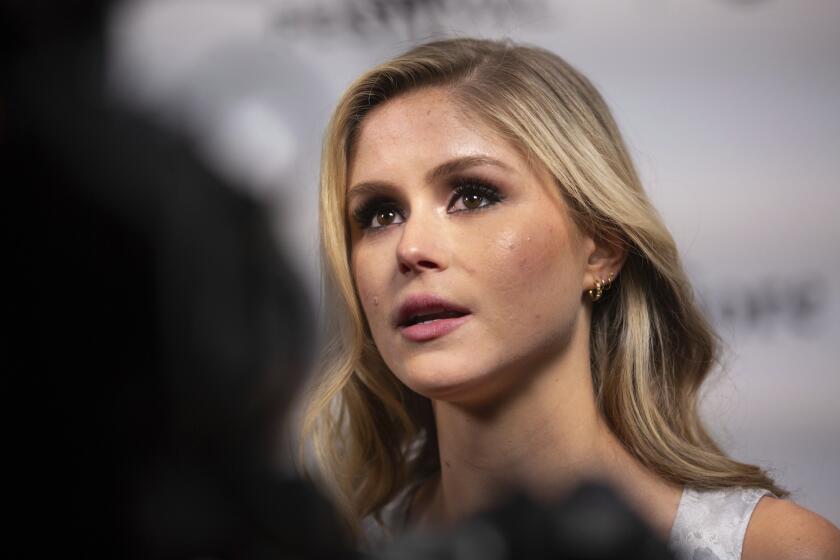Now It’s ‘Saturday Night Lame’
- Share via
So Will Ferrell and Ana Gasteyer are gone, but, surprise of surprises, “Saturday Night Live” came out of the seasonal gate Saturday looking exactly the same as it has for most of the last half-dozen years or so: like a tired, bloated icon of the television and cultural establishments that it began life dedicated to mocking.
Don’t believe the latest, entirely predictable hype about a revival at this breeding ground for a hundred last-choice movie rentals, no matter what is asserted by the folks who just gave the NBC warhorse a comedy-writing Emmy over Jon Stewart’s “Daily Show” and David Letterman’s “Late Show,” no matter what buzz may transfer to the series’ current edition from the artful and fascinating new oral history “Live from New York.”
Just because Tina Fey and Jimmy Fallon are cute and have, indeed, revivified the “Weekend Update” mock newscast doesn’t mean the 80 minutes around them merit talking about by the water cooler on Monday. “SNL” once held a central place in the nation’s living room; now it’s just a battered old couch that’s only tolerable for a few minutes at a time but that nobody quite wants to dump in the alley.
Saturday’s meager 28th-season debut--enlivened only by Bruce Springsteen’s songs, Robert Smigel’s ever-wicked cartoon and guest host Matt Damon’s virtuoso attempts to pump up a dozen flat sketches--saw “SNL” sliding into the same sloppy patterns of recent years. They are patterns the reader can see developing throughout “Live from New York,” which is really, despite all the delicious drugs and sex and back-stabbing, the chronicle of a de-evolution from the hatred of formula to its embrace, from challenging an audience to pandering to it.
There is still the amenable, big-name guest host slapped like duct tape onto every skit that doesn’t feature a stock character and most of those that do. All credit to Damon for trying to do more than just go through the motions as the show attached his celebrity to the automatic milking machine. But with 10 starring and five featured comic actors this is, or was, or could be, a comic ensemble.
There is still, most damningly, the numbing overreliance on any character who once earned a chuckle, beasts of television burden flogged harder than Regis Philbin at the peak of “Who Wants to Be a Millionaire.” Only when they appear in a movie, and that movie flops, it seems, will we see the end of Brian Fellow, Tracy Morgan’s effusive talk-show host with the sixth-grade education; or Sully and Denise, Fallon and Rachel Dratch’s meathead Boston kids; or Donatella Versace, Maya Rudolph’s bored, exhausted Euro-trash fashion maven-victim.
All have shown flashes of inspiration, especially in the performances, but their mandatory reappearances after the audience’s first flash of discovery have taken on the feel of Gary Coleman repeating “Whatchu talkin’ ‘bout, Willis?” and the sitcom audience applauding. As longtime writer Jim Downey points out in the book, the Coneheads appeared only seven times. Now, Downey says, Will Ferrell and Cheri Oteri’s cheerleaders were featured nearly 20 times in recent years. And they didn’t even get a movie out of it.
And there is still--despite its incorporation of women as comic equals--the junior high boys’ locker room fixation on a bodily orifice used for expulsion, in Saturday’s case through a commercial for an instant meal in (giant) suppository form.
Politics as Usual
Ferrell, a utility man in the Phil Hartman mode who left “SNL” after seven years because, he has said, it was time to move on, wasn’t particularly missed. As witnessed in, say, the cheerleaders, he had a talent you could admire without particularly craving more of it.
He was most noticeably absent in the opening sketch, a war-on-Iraq piece that instead of Ferrell’s President Bush relied on Darrell Hammond’s Vice President Dick Cheney.
The show has won praise for what some see as its sharp political satire, but that’s a tough sell. Yes, the nation’s leaders are being made fun of in the opening segments (their very placement also a formula), but it tends toward gentle jibes. The show turns politicians into stock characters too, rather than using them to express a transgressive point of view.
Having Cheney riding a bomb, “Dr. Strangelove”-style, headed for Iraq no matter what the United Nations or Congress may think, was a funny, broad concept, and Hammond infuses the character with a great demonic ruthlessness. But the individual lines he was given were barely political, leaning more toward throwaway pop-culture references to the likes of Anna Nicole and the kid in the Dell Computer TV ads.
Aiming at Easy Targets
There was a troubling tendency to slap such easy cultural call-outs into most sketches, as if the rest of the show was trying to borrow from the mission of “Weekend Update” (solid Saturday, if not inspired). The first commercial parody, having duck hunters shooting the AFLAC spokesfowl, was amusing and an accurate reading of the zeitgeist, but as targets go, it was a sitting duck.
It’s hard to prescribe a formula for watching “SNL” these days, because a flash of good material and better performance can appear at any moment. But if you truly want to see the comedy testing-ground aspect of it, the thing that initially made this live enterprise so exciting, then it’s probably wise to just watch the last 45 minutes, when “Update” generally runs, there’s a number from the often-excellent musical guest and the writers get a little bit of a chance to be inventive.
But even a partial viewing is strictly optional. “Saturday Night Live” these days is history. So read the book.
*
Steve Johnson is television critic for the Chicago Tribune, a Tribune company.
More to Read
The complete guide to home viewing
Get Screen Gab for everything about the TV shows and streaming movies everyone’s talking about.
You may occasionally receive promotional content from the Los Angeles Times.






